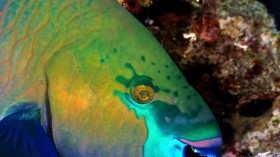Paleontologists have found what could be the earliest evidence of live birth from an ancient Mesozoic marine reptile, as evidenced by a newfound ichthyosaur fossil.
About 250 million years ago, the oceans were populated by giant marine reptiles known as ichthyosaurs, which had evolved from land-dwelling reptiles and moved into the water.
The live birth is entombed in a fossil specimen that belongs to Chaohusaurus, which is believed to be a genus of ichthyosaur. Chaohusaurus are among the oldest of Mesozoic marine reptiles.
Writing in the journal PLOS One, the paleontologists report that the Chaohusaurus specimen they've uncovered in China may show a live birth.
"The maternal skeleton was associated with three embryos and neonates: one inside the mother, another exiting the pelvis-with half the body still inside the mother-and the third outside of the mother," the researchers said in a statement. "The headfirst birth posture of the second embryo indicates that live births in ichthyosaurs may have taken place on land, instead of in the water, as some studies have previously suggested."
The researchers report that the specimen likely contains fossilized embryos that are 10 million years older than any similar embryos found so far.
Ryosuke Motani from the University of California, Davis, and his colleagues report that this evidence suggests that live birth in land reptiles may have appeared much earlier than previously believed.
"The study reports the oldest vertebrate fossil to capture the 'moment' of live-birth, with a baby emerging from the pelvis of its mother. The 248-million-year old fossil of an ichthyosaur suggests that live-bearing evolved on land and not in the sea," Motani said in a news release.
As to why the animal died, Motani told LiveScience that the reason is likely difficulty in labor. He said the first baby was likely stillborn, and the mother died from complications of having the second baby half-stuck in her body.
"Obviously, the mother had some complications," he said.
© 2024 NatureWorldNews.com All rights reserved. Do not reproduce without permission.





